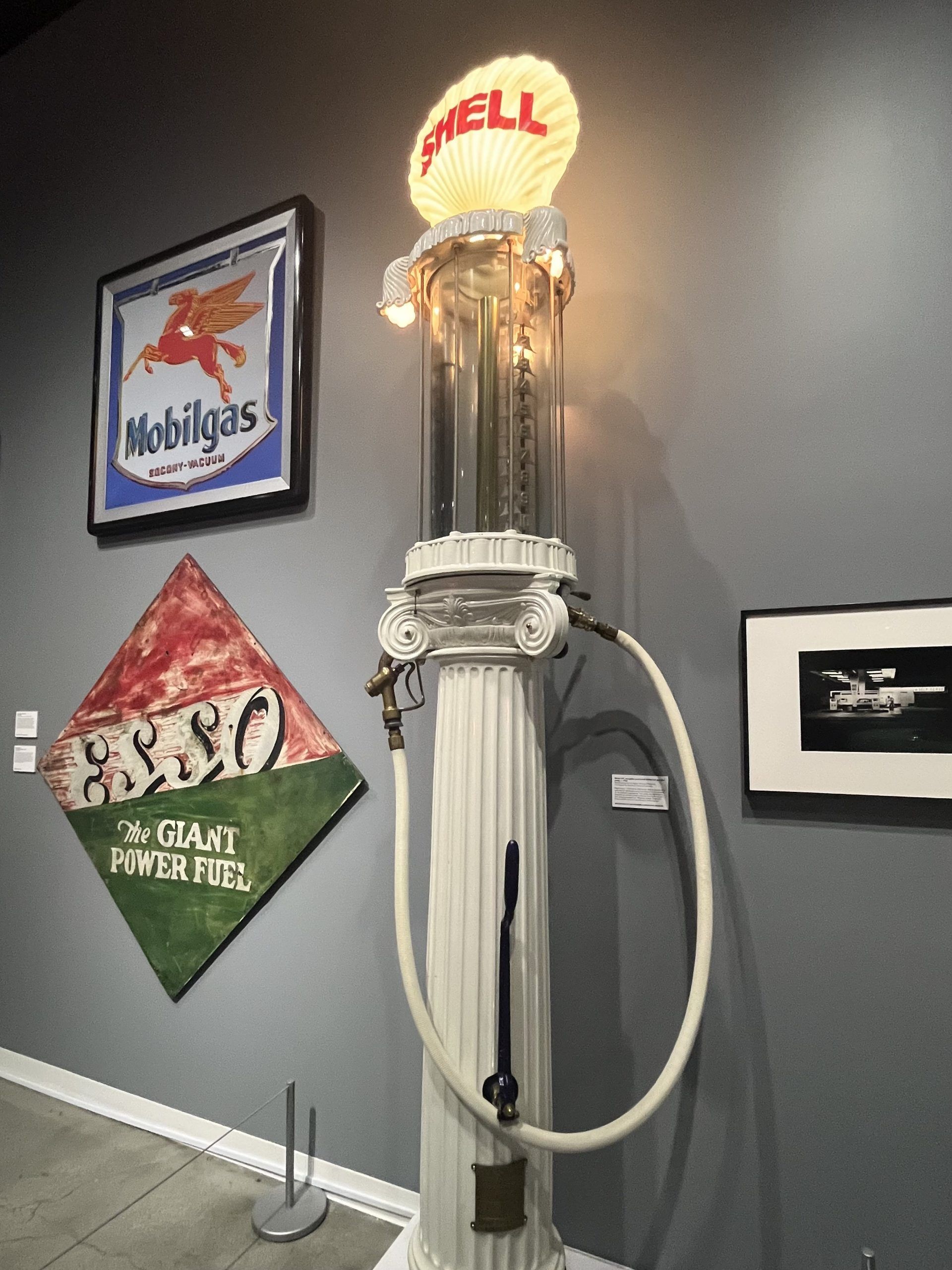One for the Road
Honk if you love Brittany Menjivar taking the scenic route at Petersen Automotive Museum’s “Eyes on the Road” exhibit.
By Brittany MenjivarJune 3, 2024

EYES ON THE ROAD: ART OF THE AUTOMOTIVE LANDSCAPE, PETERSEN AUTOMOTIVE MUSEUM, Los Angeles, March–November 2024.
Having survived a near-fatal collision, I’m constantly contemplating the automobile. Much like the characters in J. G. Ballard’s infamous novel, I pay close attention to traffic patterns on the freeway and am hyperaware of where I am in relation to various vehicles and structures when I’m behind the wheel. The new exhibition at the Petersen Automotive Museum—Eyes on the Road: Art of the Automotive Landscape—feels like it was put together for me personally. Rather than focusing solely on the craft of the car itself, the exhibition examines the manufactured symbiosis between the car and its environment, noting the way everything from signage to gas stations colludes to create the world that flies by our windows.
The history of the automobile is often sped through; Eyes on the Road encourages visitors to slow down and take the scenic route. We all learned about Henry Ford in middle school, but do we know how or when the first highways were constructed? Informative plaques mark milestones you won’t find in textbooks: uniform road signs were instituted in 1906; routes became numbered in 1929. Visual aids abound: “the world’s most beautiful visible pump,” designed to resemble a Greek column with a glowing Shell logo on top; a Route 66 sign whose all-encompassing rust turns it into a totem of days gone by.
These artifacts help contextualize artwork by the likes of Ed Ruscha, Dennis Hopper, and Roger Kuntz, all of whom have prominently featured automotive landscapes in their chronicling of the American West. Ruscha’s paintings and photographs are especially well represented here. One of his most famous prints, Standard Station (1966), depicts a gas station basked in orange light, a familiar beacon that once seemed a modern marvel. Ghost Station (2011) reduces the same image to an outline on white paper, highlighting the gas station’s status as a liminal space where the vehicle’s vulnerability is made manifest—even the biggest rigs can’t drive forever without stopping for fuel. Max Yavno’s Self Service (1978) introduces a new element to the gas station landscape: a woman, filling her tank by herself. Not only does the photograph mark the gradual shift away from full-service stations; it also indicates a turning point in human-vehicle relations, where the gas station allows for a newfound intimacy between the car and its driver.
Eyes on the Road doesn’t just look toward the past of the automotive landscape; the exhibit anticipates its future as well—as seen from the past. Illustrations by automotive designer Art Ross (ca. 1945) and promotional artist Syd Mead (ca. 1961) portray vehicles with aerodynamic builds surrounded by women in silvery dresses and bizarre headpieces. A couple of Space Age–influenced concept vehicles—the 1955 Chrysler Ghia Gilda and the 1969 Chevrolet Astro III—sit on display, adding a 3D element to the exhibition. Most fascinatingly, a wall of magazine covers shows that both popular science and automotive publications in the early to mid-20th century were concerned with representing cars in a futuristic light, showing them moving through abstract voids with the assistance of jet engines or propeller wheels. Viewing these images, I didn’t find myself fantasizing about even more fantastic contraptions, but instead reflecting upon the fact that I spend each day nonchalantly cruising around in an invention whose existence was once considered the peak of technology. What other wonders had I taken for granted?
As I did one last lap, pondering this question, the exhibition emerged as something more than a meditation on the automotive landscape alone—it was an exercise in mindfulness, as mediated by one machine.
¤
Photo of “the world’s most beautiful visible pump” by contributor.
LARB Short Takes live event reviews are published in partnership with the nonprofit Online Journalism Project and the Independent Review Crew.
LARB Contributor
Brittany Menjivar was born in the DMV; she now works and plays in the City of Angels. She serves as a Short Takes columnist for the Los Angeles Review of Books; her journalism and cultural criticism can also be found in Coveteur, Document Journal, and V Magazine, among other outlets. She is the author of the poetry and prose collection Parasocialite (2024) and the co-founder of literary reading series Car Crash Collective. As a screenwriter (Fragile.com), she has been recognized as an AT&T Hello Lab Filmmaking Fellow.
Did you know LARB is a reader-supported nonprofit?
LARB publishes daily without a paywall as part of our mission to make rigorous, incisive, and engaging writing on every aspect of literature, culture, and the arts freely accessible to the public. Help us continue this work with your tax-deductible donation today!